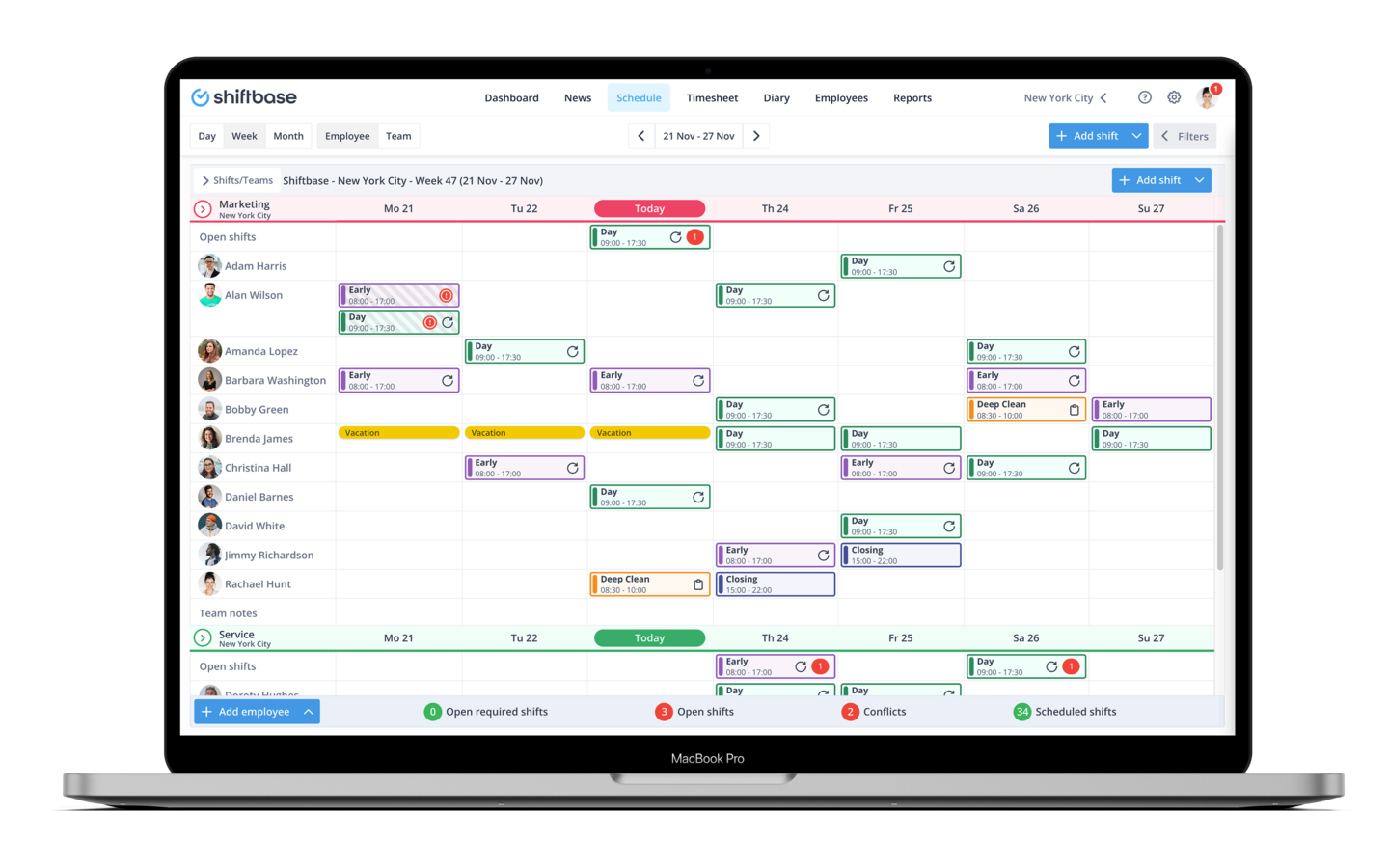About this template
Excel is used by many companies to keep track of the hours worked by their employees. A time attendance sheet can be customized easily to the needs of any user. To simplify time tracking even further and to bridge the gap until you can switch to Shiftbase, we offer you this free time tracking template.

A timesheet template in Excel is an efficient way to keep track of hours worked by employees or contractors. It is an essential tool for payroll, invoicing, and project management. Not only does it simplify record-keeping, but it also helps to ensure accuracy and transparency.
Why Use Excel for Timesheets?
In a world full of diverse tools and software options, why should one opt for Excel when it comes to creating timesheets? Below are several compelling reasons that demonstrate the unmatched advantages of using Excel for this purpose.
-
Accessibility: Excel is a part of the Microsoft Office Suite, which is available to millions of users worldwide. Whether you are using a PC or a Mac, Excel is readily accessible. Its presence on most workplace computers means you likely won't need special permissions or additional downloads to start creating your timesheet.
-
Familiarity: Given its longstanding history, Excel is a tool that many people have encountered at some point in their education or career. This widespread familiarity is invaluable. Employees and employers alike likely already have at least a basic understanding of how Excel functions. This familiarity can significantly decrease the time it takes for a team to adapt to using a new timesheet system.
-
Flexibility and Customization: Excel is a remarkably flexible tool. Whether you need a simple table to track hours or a complex system that logs different types of work, calculates overtime, and integrates with other data – Excel can handle it. You can tailor your timesheet exactly to your specifications, allowing you to add or remove features as your needs change.
-
Powerful Calculations and Formulas: One of Excel’s defining features is its capability to perform complex calculations. When using Excel for timesheets, you can easily set it up to automatically calculate total hours worked, overtime, pay, and other essential metrics. These automations can drastically reduce manual errors and save time.
-
Data Analysis and Reporting: Beyond basic timesheet functions, Excel offers robust data analysis tools. Pivot tables, charts, and graphs can help transform the raw time data into actionable insights, allowing managers and employees to identify trends, inefficiencies, or areas for improvement.
-
Integration Capabilities: Excel doesn’t exist in a vacuum; it is designed to work seamlessly with other Microsoft products, and it can also integrate with a wide array of third-party software. This means that your timesheet data can easily be imported into your company’s payroll system, project management software, or other tools your team uses regularly.
-
Security Features: Excel comes with a variety of security options, including password protection and restricted access features. These options can help ensure that sensitive information, such as employee hours and pay rates, remains confidential.
-
Cost-Effectiveness: While there are specialized timesheet software options on the market, they often come with a subscription fee. For businesses already using the Microsoft Office suite, using Excel for timesheets is a cost-effective choice, as it doesn't incur additional costs.
Components of an Effective Timesheet Template
An effective timesheet template is more than just columns and rows. It should be:
- Intuitive and easy to use
- Detailed with categories like date, start time, end time, breaks, and total hours worked
- Customizable to fit the specific needs of your business or project.
Designing Your Excel Timesheet

Starting with Basics
- Columns and Rows to Include: Standard columns may include Date, Start Time, End Time, Breaks, and Total Hours. Rows can represent different days of the week or different employees.
- Input Fields and Categories: Besides hours worked, you might need fields for job codes, projects, or departments.
Formatting Your Timesheet
Making a timesheet should not feel like rocket science.
- Making it Visually Appealing: Use font styles, cell shading, and border options to make the timesheet easy to read.
- Data Validation and Restrictions: Set rules to prevent incorrect entries, such as negative time values.
Enhancing Your Timesheet with Excel Features
Excel is more than a digital piece of grid paper. It’s a powerful tool capable of complex calculations and visualizations.
- Utilizing Formulas for Automation: For instance,
=SUM(E2:E8) can be used to calculate the total hours worked in a week.
- Creating Data Visualizations: Charts and graphs can make trends and patterns instantly visible, transforming raw data into actionable insights.
Securing and Sharing Your Excel Timesheet
Your timesheet template might contain sensitive information. Protect it.
- Password Protection: This feature in Excel allows you to secure your document with a password, ensuring that only authorized individuals have access.
- Sharing and Collaboration Features: Excel allows for cloud storage and sharing through OneDrive or SharePoint, facilitating teamwork.
Troubleshooting Common Issues
- Handling Errors and Inconsistencies: Conditional formatting can highlight errors in your timesheet, making them easier to spot and correct.
- Optimizing for Different Versions of Excel: Not all features are available in every version of Excel, and older versions may require different approaches to achieve the same result.
Limitations of Excel Timesheets
While Excel is a powerful and versatile tool that offers numerous advantages for creating timesheets, it is not without its drawbacks. Below are some of the limitations that users might encounter when using Excel for timesheet management:
- Manual Entry and Human Errors: One of the most significant drawbacks of using Excel for timesheets is the reliance on manual data entry. This can lead to human errors, such as incorrect entries or accidental deletions, which can result in inaccurate payroll and reporting.
- Lack of Real-Time Tracking: Unlike specialized timesheet software, Excel does not have the capability for real-time tracking of hours worked. This means employees must remember and manually enter their hours, which can lead to inaccuracies.
- Limited Access and Collaboration: While Excel does offer some collaboration features, especially with its integration with OneDrive or SharePoint, it may not be as seamless or intuitive as cloud-based timesheet solutions. Multiple people working on the same file can lead to version control issues.
- Lack of Integration with Other Systems: Excel may not integrate seamlessly with a company’s existing payroll, HR, or project management systems. This could require additional manual work to transfer data between systems.
- Scalability Issues: For larger organizations with a significant number of employees, managing timesheets in Excel can become unwieldy and time-consuming. Specialized software solutions might offer more efficient scalability options.
- No Automated Backup or Recovery: Unlike cloud-based systems, Excel files saved on a local drive do not have automatic backup and recovery options, which means that important data can be lost if the file becomes corrupted or is accidentally deleted.
- Lack of Mobile Accessibility: While Microsoft offers mobile versions of Excel, they might not be as user-friendly or feature-rich as their desktop counterparts. This can make it difficult for employees to update their timesheets on-the-go.
- Customization Requires Skill and Time: Creating a tailored, sophisticated Excel timesheet that meets specific business needs requires a deep understanding of Excel’s features and takes time to develop. This might be impractical for small businesses with limited resources.

A Modern Solution to Excel Timesheet Limitations: Shiftbase
While Excel can be a reliable tool for creating timesheets, it has its own set of limitations, as discussed earlier. If you’re feeling restricted by manual entry, limited collaboration, or the lack of real-time tracking and automated alerts in Excel, it may be time to explore a more specialized solution. Enter Shiftbase, a comprehensive SaaS for workforce management. With Shiftbase, you can effortlessly manage employee scheduling, time tracking, and absence management, all in one user-friendly platform. Shiftbase is designed to simplify your workforce management tasks, offering customizable and automated solutions that adapt to the unique needs of your business. Say goodbye to the tedious and error-prone manual processes that come with using Excel for timesheets and embrace the modern, streamlined functionalities that Shiftbase offers.
Ready to Make the Switch?
Don’t just take our word for it - experience the difference for yourself. Shiftbase is inviting you to try our software free for 14 days. This is a no-risk opportunity to explore all of our premium features, and there’s no obligation to continue after the trial period. Are you ready for a smarter, more efficient way to manage your workforce? Sign up for your free 14-day trial of Shiftbase now.



